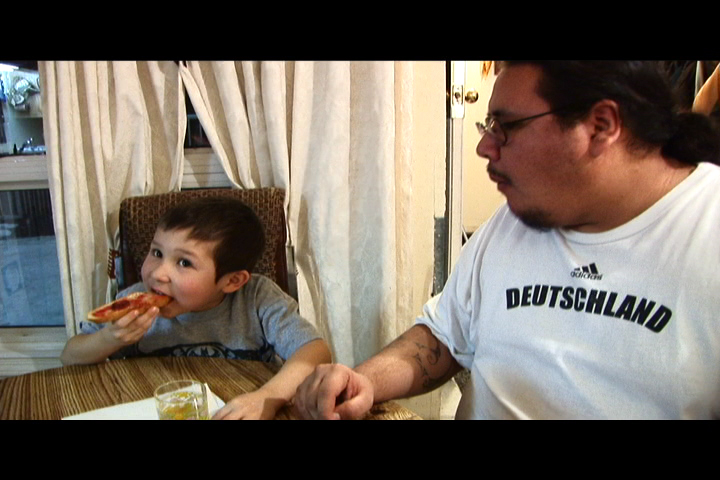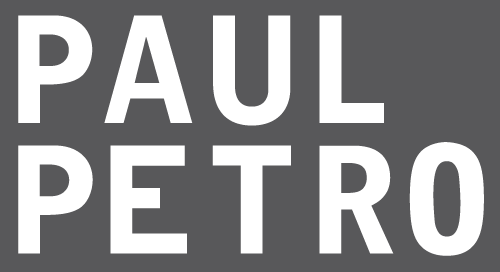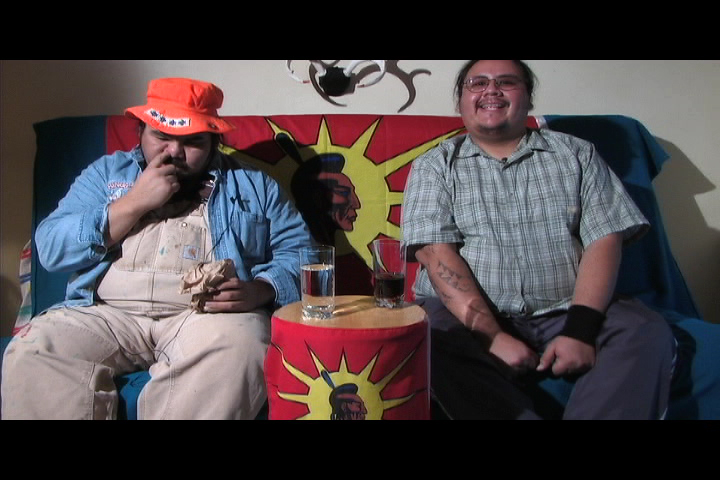Darryl Nepinak's Throwbacks
Darryl Nepinak
April 11 - April 26, 2014

Paul Petro Contemporary Art is pleased to present Darryl Nepinak’s Throwbacks, a survey of the 'greatest hits’ by Nepinak. The programme includes eight video works produced between 2005-2012. This exhibition is presented in cooperation with the Images Festival.
From the Images Festival web site:
"Zwei Indianer Aus Winnipeg is a 16mm film based on the 1964 German song, Zwei Indianer Aus Winnipeg, in which two ersatz “Indian warriors” chase a beautiful Indian maiden through the streets of Winnipeg. In Good Morning Native America, Nepinak hosts a cable morning show from his basement, showing off goods such as his granny’s bingo card collection. Indian is a short experimental found footage video collage and Tontos is an experimental exploration of the intro to the 1950s television show The Lone Ranger. I for NDN, which Nepinak made with Clint Enns, depicts the classic spelling bee, “rez style.” Bannock documents Nepinak’s mother as she relates stories of how she learned to make bannock, and Last of the Nepinaks is a video of a nephew’s journey.
"Together with an exhibition of works by Bosnian-Canadian artist Sadko Hadzihasanovic, Darryl Nepinak’s Throwbacks draws attention to marginalized peoples. Respectively, these programs explore Roma and First Nation race relations within urban contexts and the humour and pathos that can be found in the two artists’ works."
Darryl Nepinak is a Saulteaux from the Ojibwe Nation. He works as an arts facilitator with inner city youth in Winnipeg, Manitoba. Nepinak was previously on the board of Urban Shaman Gallery in Winnipeg. Nepinak ‘s films have screened at numerous venues around the world including at the imagineNATIVE Film + Media Art Festival in Toronto, the National Museum of the American Indian in New York, and the Berlin International Film Festival in Germany. He is currently writing a pilot, The Band Office, for Aboriginal Peoples Television Network and is directing 10 short films with the National Film Board.
Darryl Nepinak acknowledges the support of his work from The Winnipeg Arts Council, The Manitoba Arts Council and the National Film Board of Canada.
Description of works:
LAST OF THE NEPINAKS, running time 02:56 Colour, tape, 2005. "A nephews journey”
GOOD MORNING NATIVE AMERICA, running time 05:00, colour, mini dv, 2006. "Check out granny's bingo card collection and more on everybody's favourite morning show, coming to you from Darryl's basement and over your local cable television network."
BANNOCK, running time 06:55 Colour, mini dv, 2007. "Darryl Nepinak documents his mother as she teaches him and shares stories of how she learned how to make Bannock. A step by step way of teaching others about what is bannock and how to make it.”
BIGFOOT, running time 13:42, colour, mini dv, 2007. "A Mockumentary about a group of misfit hunters in not-so-hot pursuit of the legendary Bigfoot somewhere between Sapatoweyak and Skownan Brief Description"
ZWEI INDIANER AUS WINNIPEG, running time 02:45, colour, 16mm, 2008. "Two ersatz "Indian warriors" chase a beautiful Indian maiden through the streets of Winnipeg. But she loves Chief Big Bear. Who is the hunter, and who the hunted in this tableaux? Based on the 1964 German song, Zwei Indianer Aus Winnipeg, our heroes are in for a surprise when they reach The Ancient Lake of Schwinestieger."
INDIAN, running time 01:30 colour, mini dv, 2008. "The classic Spelling Bee, 'Rez style'! "
I for NDN, Darryl Nepinak & Clint Enns, running time 01.34 Colour, mini dv, 2011. "Experimental found footage."
TONTOS, running time 0:46 B&W, Exp, 2012. "Experimental Short of the Lone Ranger Intro 1950's Television show"
Double Feature: Darryl Nepinak and Jackie Traverse
Art Gallery of Southwestern Manitoba, Brandon, Manitoba
Curated by Jenny Western
13 January – 26 February, 2011
Review by Andrew Harwood and Jonah Corne (first printed in Fuse Magazine, Spring 2011)
It is tempting to view Double Feature: Darryl Nepinak and Jackie Traverse, an exhibition in Brandon, Manitoba, 200 kilometres outside of Winnipeg, as a kind of preview of Close Encounters: The Next 500 Years, the art-star-studded spectacular of Indigenous art showing in the city. The peripherally located show, however, is itself a major event.
Darryl Nepinak, from the Saulteaux tribe, works primarily in video. Jackie Traverse, from the Anishinabe tribe, works in several media, including video and painting. Both based in Winnipeg, they use wit, irony and humour to confront immensely devastating subject matter. If the “comic” in their work serves as a form of “relief,” it does not neutralize the repercussions of colonialism, but upsets expectations about “proper” representations of oppression and suffering.
Nepinak’s six videos from 2006 to 2009 comprise his work in Double Feature. Each of these videos deconstructs a different genre from movies or television: the morning talk show; the cooking show; the western; the ethnographic documentary; the music video; and coverage of a spelling bee. Nepinak employs a transparently barebones, lo-fi ap- proach, which allows his ideas and concepts to assert themselves with maximum clarity. Watched consecutively, the videos in Double Feature strike the viewer almost like a pilot episode of a Native version of Mad TV — a comparison to which Nepinak, fond of pop culture even as he plunders and critiques it, would not likely object.
I-N-D-I-A-N (2008), the spelling bee send- up, is perhaps the program’s most succinctly powerful piece. The two-minute video consists of two identically set up static shots. First, Nepinak appears in front of a microphone dressed in a button-down shirt, nerdishly buttoned to the top, a yellow contestant number slung around his neck. An off-screen authoritative voice asks him to spell the word “Indian,” a seemingly easy task since the contestant is a grown-up and the word isn’t exactly “ichthyology.” Looking perplexed, Nepinak hesitates and asks: “Can I please get the meaning of the word?” “Can I please get the language of origin?” and “Can you use it in a sentence?” Taking a deep breath, Nepinak settles on an answer: “N. D. N.”: a slang spelling of the word, which the authoritative judge shoots down and “corrects.” Nepinak responds with the quip: “Oh, just like on the Rez.” Characteristically multiplying punch lines, the video cuts to a middle-aged white contestant asked to spell “genocide,” and the piece abruptly ends.
In this deceptively simple video, Nepinak crystallizes how language and education have been used to perpetuate colonialism. The spelling bee is exposed as an exercise in mindless obedience and linguistic coercion. Mistakenly applied to First Nations peoples by Spanish explorers in the 15th century, the word “Indian” might be better spelled “N.D.N” — a self-chosen identification. Zwei Indianer Aus Winnipeg (2009), which screened at the Berlin International Film Festival, takes its name from a 1964 German pop song by Marika Kilius, an Olympic medal-winning figure-skater who enjoyed a side-career as a singer in the yé-yé mould. Its title translating as Two Indians from Winnipeg, the song is gleefully, nuttily racist — a quality which Nepinak’s video basks in and exploits for absurdist effect. Serving as an ersatz music video for the song, the video features two white men masquerading as Indians chasing a beautiful native woman through the streets of downtown Winnipeg. At the end, the two submerge themselves in a lake and re-emerge metamorphosized into what appear to be “authentic” native men. Yet the two newly emerged “Indians” continue to chase the beauty — perhaps demonstrating that men are dogs, and that sometimes gender trumps race.
Issues of identity are explored within a more explicitly autobiographical framework in Jackie Traverse’s half of the exhibition, which combines two stop-motion animations, Two Scoops (2008) and Empty (2009), and her acrylic painting series Childhood Memories (2010). Imbued with an emotional depth by their handcrafted elements, the videos focus on narratives involving, respectively, government-enforced foster care and adoption, and an alcoholic mother. Signaling a progression from her videos, Traverse’s paintings rework similar subject matter, but with a more distinctive voice and with added intricacies of humour and irony.
Memory plays a much more active role in her paintings, distorting representation and accentuating the uncertainty of remembrance. Employing the denigrated genre of caricature, considered the domain of cartoonists and carnival portraitists, Traverse’s paintings depict figures with oversized heads and exaggerated facial features. These figures are set against backgrounds of swirling brushstrokes, removing the subjects from any realistic context, placing them in a psychic memory-space. Context is conjured by Traverse’s casually tacked-up notes, neatly printed in pencil on sheets of loose-leaf paper — suggesting a schoolgirl’s notebook. This pre-emptive seizure of control over the conventional gallery card works brilliantly; the notes become part of the total work without impeding the evocativeness of her images.
In her note accompanying The Bats of Lake St. Martin, one of the most absorbing paintings of the series, Traverse writes: “This is how I imagined a bat carrying me away. My mom told me that if I didn’t wear my hat the bats would grab me by my hair and carry me away to go live with them.” The canvas shows a little girl, dressed in a fur-cuffed coat, letting out a scream as she is dragged skyward by the swooping creature. In this cautionary myth, fabricated by her mother and vividly imagined by the artist as a child, Traverse returns to the terror of being stripped away from the home depicted in Two Scoops. Here, however, it is represented in a much more mythological manner. This is also true of Uncle Rudy, a painting of a dour white woman in uniform with a brood of kittens in her arms, based on a story told by Traverse’s aunt, who told her that her missing kittens were taken away by children’s aid and put in a foster home.
In Traverse’s paintings, the oversized heads are constant targets, sites of vulnerability. In Perms, the head is attacked not by a malicious bat, but by her mother’s questionable good intentions. “When I was in grade 3 my mom gave me and my little sister Pammy Afro perms. I took one look in the mirror and started to cry. Pammy liked hers,” the note to the painting reads in perfect deadpan. Sporting flared jeans, a striped t-shirt, and a giant bowl-like do — typical 70’s African-American, Brooklyn style — the artist again pictures herself with a wide-open screaming mouth, distressed at her imposed new identity. As the painting engages this key problem, it is emotionally complicated by the little sister, who smiles while cradling a teddy bear, perhaps naively content with her new ’fro.
Nepinak and Traverse use humour to allow us to enter the stories of their lives. Deeply political, their work is never didactic, relying on powerful emotional cues that mingle hilarity and disquietude. The legacies of colonialism can never be erased, but these artists laugh in the face of hegemony and history.
JONAH CORNE teaches film studies in the Department of English, Film, and Theatre at the University of Manitoba.
ANDREW HARWOOD is a Winnipeg-based artist, writer and curator with a penchant for shiny things.



